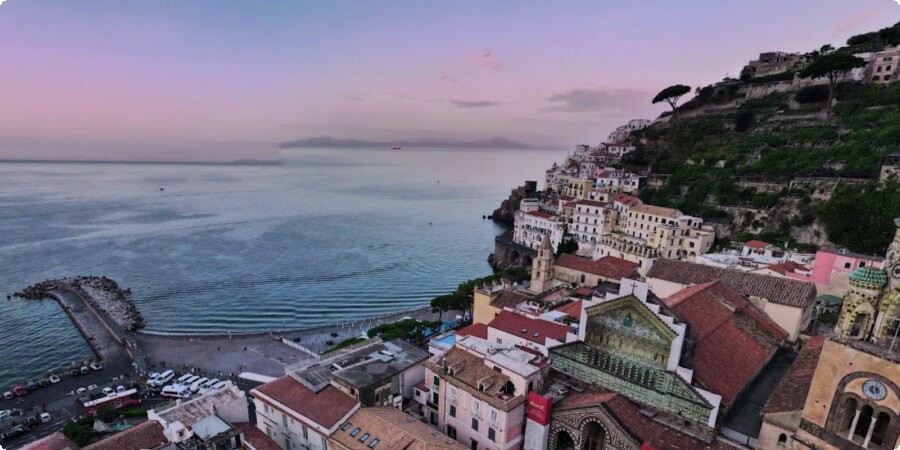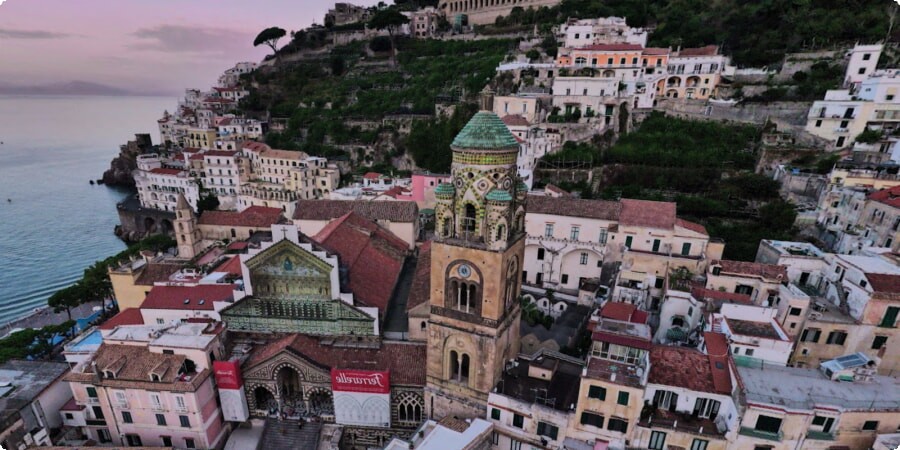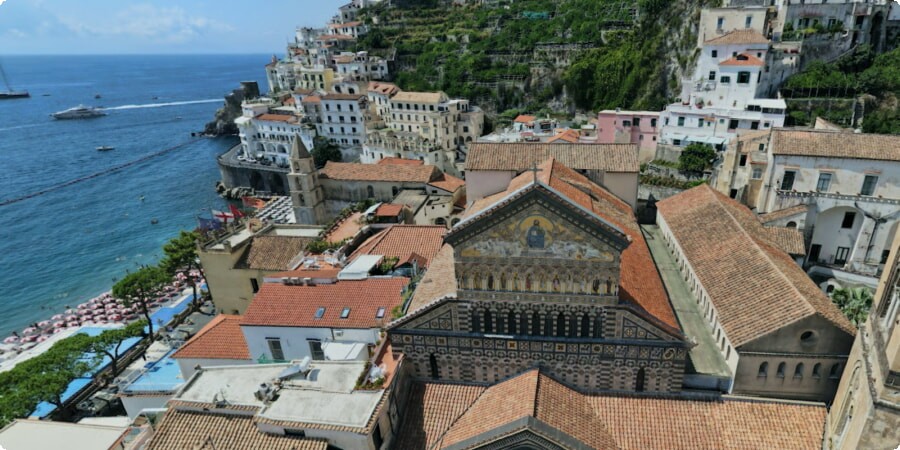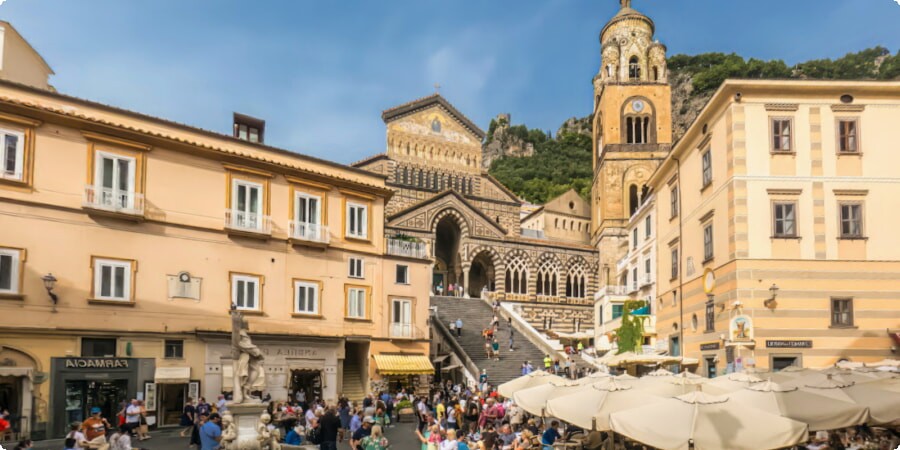The Duomo di Amalfi, also known as the Cathedral of Saint Andrew, is a breathtaking blend of Romanesque, Byzantine, Gothic, and Baroque architectural styles. Located in the heart of the picturesque town of Amalfi on the Amalfi Coast, this cathedral is not just a place of worship but a treasure trove of art, history, and culture. Its towering facade, intricate interiors, and historical significance make it a must-visit destination for anyone exploring southern Italy.
Stepping into the Duomo di Amalfi is like walking through a portal to the past, where every corner tells a story of devotion, artistry, and architectural brilliance. Whether you are a history buff, an art enthusiast, or a spiritual seeker, the Duomo offers something profound and inspiring. The cathedral, dedicated to Saint Andrew, the patron saint of Amalfi, houses his relics and stands as a testament to the town’s rich maritime heritage and religious fervor.
Learn more about Amalfi and its history on Wikipedia.
Explore the location of the Duomo di Amalfi on Google Maps.
The Facade: A Stunning First Impression
The facade of the Duomo di Amalfi is an architectural marvel that captures the attention of every visitor even before they step inside. Designed in the Arab-Norman style, the facade underwent several transformations over the centuries, blending various architectural influences that reflect the rich cultural tapestry of Amalfi’s history.
Architectural Details
- Mosaic Artwork: One of the most striking features of the facade is the vibrant mosaic of Christ enthroned, flanked by angels and saints. This stunning mosaic, created by Neapolitan artists in the 19th century, adds a splash of color and divine imagery to the cathedral’s entrance.
- Gothic Influences: The pointed arches and intricate detailing of the facade showcase Gothic architectural elements. These details, combined with the Romanesque base, create a harmonious blend that is both unique and captivating.
- Bronze Doors: The cathedral’s bronze doors, cast in Constantinople in the 11th century, are a masterpiece in their own right. The doors feature intricate designs and inscriptions, depicting scenes from the life of Christ and Saint Andrew.

A Gateway to Grandeur
The facade is not just a beautiful exterior; it is a symbolic gateway that prepares visitors for the grandeur inside. As you stand before the facade, take a moment to appreciate the intricate craftsmanship and the historical layers embedded in its design. The steps leading up to the cathedral add to the dramatic entrance, giving you a sense of ascending to a higher, sacred space.
For those traveling from Milan, renting a car can provide a convenient and scenic journey along the Amalfi Coast. Book a car in Milan here.
The Atrium: A Gateway to History
Before entering the main nave of the Duomo di Amalfi, visitors pass through the atrium, a serene and historically significant space that sets the tone for the spiritual and cultural journey ahead. The atrium, or forecourt, is a rectangular courtyard surrounded by arches, providing a tranquil prelude to the grandeur inside the cathedral.
Historical Significance
- Meeting Place: Historically, the atrium served as a gathering place for the faithful, where they would prepare themselves for worship. It was also used for important civic meetings and events, highlighting its role as a communal space.
- Architectural Harmony: The columns and arches of the atrium are adorned with decorative capitals and medieval sculptures, showcasing the craftsmanship of the period. The harmonious design of the atrium reflects the architectural coherence that characterizes the entire cathedral complex.
Key Features to Observe
- Columns and Capitals: The columns in the atrium are a mix of ancient Roman and medieval styles, each with uniquely carved capitals. These details offer a glimpse into the historical layers and artistic influences that shaped the cathedral.
- Frescoes and Inscriptions: Although many have faded over time, some frescoes and inscriptions are still visible on the walls of the atrium. These artworks provide insight into the religious and cultural narratives of the past.
- View of the Facade: From the atrium, you can enjoy a different perspective of the cathedral’s facade, framed by the elegant arches of the courtyard. This view allows for a moment of reflection and appreciation of the architectural beauty before entering the main church.
The atrium of the Duomo di Amalfi invites visitors to pause and absorb the rich history that permeates the site. It serves as a gentle transition from the bustling town square to the sacred interior of the cathedral.

The Cloister of Paradise (Chiostro del Paradiso)
The Cloister of Paradise, or Chiostro del Paradiso, is one of the most enchanting parts of the Duomo di Amalfi complex. Built between 1266 and 1268, this cloister served as a burial ground for noble families of Amalfi. Today, it stands as a serene oasis of art and history.
Architectural Highlights
- Arab-Norman Style: The cloister is a splendid example of Arab-Norman architecture, characterized by its elegant arches and slender columns. The interplay of light and shadow within the arches creates a tranquil and almost otherworldly atmosphere.
- Mosaic Work: The walls of the cloister are adorned with beautiful mosaics, depicting religious and historical scenes. These artworks offer a glimpse into the rich cultural heritage of Amalfi and its artistic traditions.
Notable Features
- Garden: At the center of the cloister is a lovely garden, filled with palm trees and Mediterranean flora. The garden's peaceful ambiance makes it a perfect spot for contemplation and relaxation.
- Sarcophagi: The cloister houses several ancient sarcophagi, intricately carved with scenes from mythology and the lives of saints. These artifacts provide a fascinating insight into the funerary practices and artistic expressions of medieval Amalfi.
A Tranquil Retreat
Visiting the Cloister of Paradise is like stepping back in time. The serene environment, combined with the architectural beauty and historical significance, makes it a must-see for anyone visiting the Duomo di Amalfi. Take your time to walk through the cloister, admire the detailed carvings, and soak in the peaceful atmosphere.
Discover more about the Cloister of Paradise on Wikipedia.

The Crypt of St. Andrew
The Crypt of St. Andrew, located beneath the main altar of the Duomo di Amalfi, is a sacred space that holds the relics of St. Andrew, the apostle and patron saint of Amalfi. This crypt is not only a place of religious significance but also a masterpiece of Baroque art and architecture.
Historical Background
- Relics of St. Andrew: According to tradition, the relics of St. Andrew were brought to Amalfi from Constantinople during the Fourth Crusade in 1206. These relics have made the Duomo di Amalfi a significant pilgrimage site for centuries.
- Baroque Renovation: The crypt was renovated in the Baroque style in the 17th century by architect Domenico Fontana. The rich decorations and dramatic flair of the Baroque elements add a layer of opulence to this sacred space.
Art and Architecture
- Frescoes: The walls and ceiling of the crypt are adorned with stunning frescoes depicting scenes from the life of St. Andrew. These frescoes, created by local artists, bring the saint’s story to life in vivid color and detail.
- Marble Altar: At the heart of the crypt is a magnificent marble altar, intricately carved and inlaid with precious stones. The altar is flanked by statues of saints and angels, adding to the spiritual atmosphere.
- Reliquary: The relics of St. Andrew are housed in a beautiful reliquary, which is displayed prominently in the crypt. Pilgrims and visitors alike can pay their respects and reflect on the saint’s legacy.
Spiritual Significance
Visiting the Crypt of St. Andrew offers a deeply spiritual experience. The serene environment, combined with the stunning art and architecture, creates a space for reflection and prayer. Whether you are a pilgrim or a tourist, the crypt provides a profound connection to the history and spirituality of Amalfi.
Explore more about the Crypt of St. Andrew on Wikipedia.
For those planning a broader exploration of Italy, consider renting a car to enhance your travel experience. Book a car in Italy here.

The Main Nave and Interior Decor
Stepping into the main nave of the Duomo di Amalfi is like entering a grand and sacred hall that reflects centuries of artistic and religious devotion. The interior decor of the cathedral is a stunning amalgamation of various styles, each contributing to its majestic ambiance.
Overview of the Nave's Design
- Romanesque Roots: The core structure of the nave retains its Romanesque roots, with sturdy columns and rounded arches. These elements provide a solid and harmonious foundation for the more elaborate decorations added in later periods.
- Baroque Splendor: The interior was extensively remodeled in the Baroque style during the 17th century. This transformation introduced lavish decorations, including gilded stucco, intricate frescoes, and opulent altars.
Significant Artworks and Decorations
- Ceiling Frescoes: The ceiling of the nave is adorned with beautiful frescoes that depict scenes from the life of Christ and the Virgin Mary. These vibrant artworks, framed by ornate stucco work, draw the eyes upward and inspire awe.
- Side Chapels: Along the sides of the nave are several chapels, each dedicated to different saints and adorned with altarpieces, sculptures, and paintings. These chapels offer quiet spaces for prayer and reflection.
- Main Altar: The main altar of the Duomo di Amalfi is a masterpiece of Baroque art. It is richly decorated with marble, gold leaf, and religious iconography. The altar is the focal point of the nave, drawing worshippers and visitors alike.
Ambiance and Spirituality
The interior decor of the Duomo di Amalfi creates an atmosphere of grandeur and spirituality. The harmonious blend of Romanesque solidity and Baroque opulence reflects the cathedral’s long history and its significance as a center of faith and art. As you walk through the nave, take your time to appreciate the intricate details and the serene ambiance that makes the Duomo di Amalfi a truly special place.
The Bronze Doors
The bronze doors of the Duomo di Amalfi are a significant highlight, both artistically and historically. These doors, crafted in Constantinople in the 11th century, are among the earliest examples of Byzantine bronze work in Italy.
Origin and Historical Significance
- Byzantine Craftsmanship: Commissioned by Pantaleone di Mauro Comite, a wealthy Amalfitan nobleman, the doors were created in Constantinople, the heart of the Byzantine Empire. This connection underscores the maritime and cultural links between Amalfi and the Eastern Mediterranean.
- Historical Journey: After being transported across the sea, the doors were installed in the cathedral around 1060. Their arrival marked a significant event, emphasizing Amalfi’s importance and its connections with the Byzantine world.
Artistic Details and Craftsmanship
- Intricate Panels: The doors are composed of 28 intricately decorated panels. Each panel depicts different scenes from the life of Christ, the Virgin Mary, and various saints. The detailed relief work showcases the exceptional skill of Byzantine artisans.
- Latin Inscriptions: Surrounding the panels are Latin inscriptions, which include biblical verses and dedications. These inscriptions not only add to the artistic value but also provide historical and religious context.
- Restoration Efforts: Over the centuries, the bronze doors have undergone several restoration efforts to preserve their beauty and integrity. These efforts ensure that visitors today can still appreciate the original craftsmanship.
The bronze doors of the Duomo di Amalfi stand as a testament to the town’s historical significance and its role as a cultural bridge between East and West. They are a must-see for anyone visiting the cathedral, offering a tangible link to the medieval past.
Learn more about Byzantine art on Wikipedia.
The Bell Tower
The bell tower of the Duomo di Amalfi, with its distinctive architectural style and commanding presence, is another iconic feature of the cathedral complex. Standing tall next to the cathedral, the bell tower has served as a symbol of Amalfi’s maritime heritage and religious devotion for centuries.
History and Architectural Style
- Construction: The bell tower was constructed between the 12th and 13th centuries, during the height of Amalfi’s power and influence as a maritime republic. Its design reflects the Romanesque architectural style prevalent at the time.
- Distinctive Features: The tower’s most distinctive feature is its Arab-Norman influence, visible in the decorative arches and the use of colored tiles. This blend of styles reflects Amalfi’s cultural connections with the Arab world and Norman Sicily.
Importance to the Cathedral
- Functionality: Historically, the bell tower played a crucial role in the daily life of the cathedral and the town. The bells were used to call the faithful to prayer, mark the hours, and signal important events.
- Architectural Harmony: The tower’s design complements the overall architectural harmony of the cathedral complex. Its height and elegance add to the visual impact of the Duomo, making it a focal point of the Amalfi skyline.
Visiting the Bell Tower
While the bell tower is not always open to the public, its exterior can be admired from various vantage points around the cathedral. For those interested in exploring more of Amalfi’s architectural treasures, consider renting a car to discover the town and its surroundings at your own pace.
Book a car in Italy here for a convenient travel experience.
The Museum: Treasures of the Duomo
The museum of the Duomo di Amalfi, located within the cathedral complex, is a treasure trove of religious artifacts, historical documents, and artworks that offer a deeper understanding of the cathedral’s rich heritage. It provides visitors with an opportunity to explore the cultural and artistic history of Amalfi in a more intimate setting.
Overview of the Museum
- Exhibition Rooms: The museum is housed in several rooms that were once part of the cathedral’s cloister and other ecclesiastical buildings. These spaces have been carefully preserved and adapted to showcase the collection.
- Curated Collections: The exhibits are curated to highlight the religious, artistic, and historical significance of the items on display. Each piece is accompanied by detailed descriptions, providing context and insight.
Notable Artifacts and Exhibits
- Religious Relics: Among the most important items in the museum are the relics associated with St. Andrew and other saints. These relics, housed in beautifully crafted reliquaries, underscore the cathedral’s role as a major pilgrimage site.
- Liturgical Objects: The museum’s collection includes a variety of liturgical objects, such as chalices, crosses, and vestments. These items, often made of precious metals and adorned with intricate designs, reflect the craftsmanship and devotion of their creators.
- Manuscripts and Documents: The museum also holds a significant collection of medieval manuscripts and historical documents. These texts provide a fascinating glimpse into the religious, social, and political life of Amalfi through the ages.
Exploring the Museum
Visiting the museum of the Duomo di Amalfi offers a deeper appreciation of the cathedral’s artistic and historical legacy. It allows visitors to see up close the treasures that have been safeguarded for centuries, each telling its own story of faith, artistry, and heritage.
